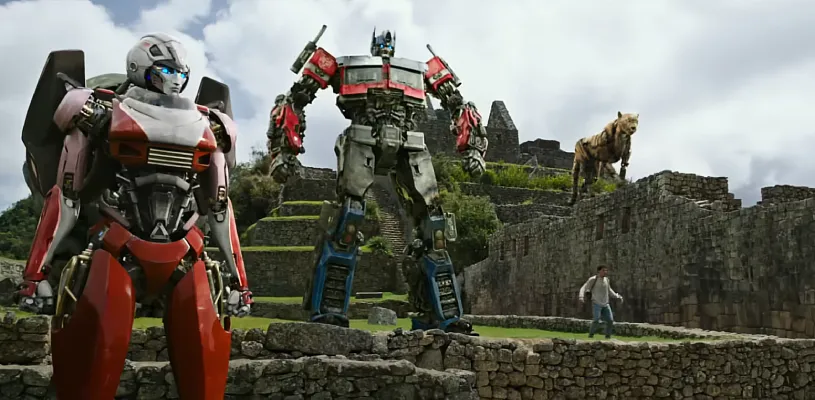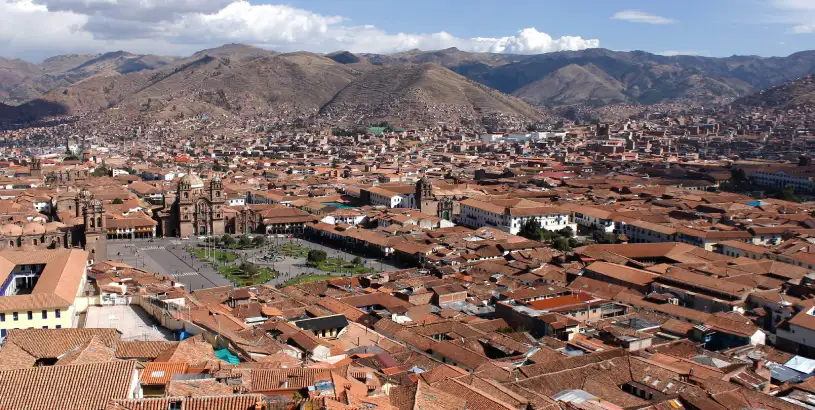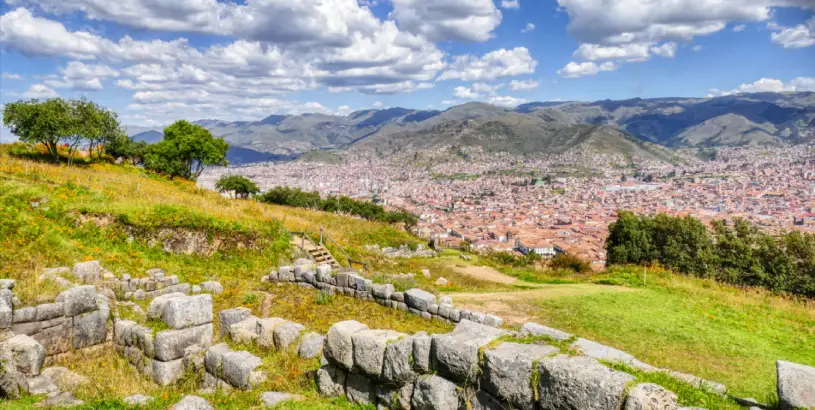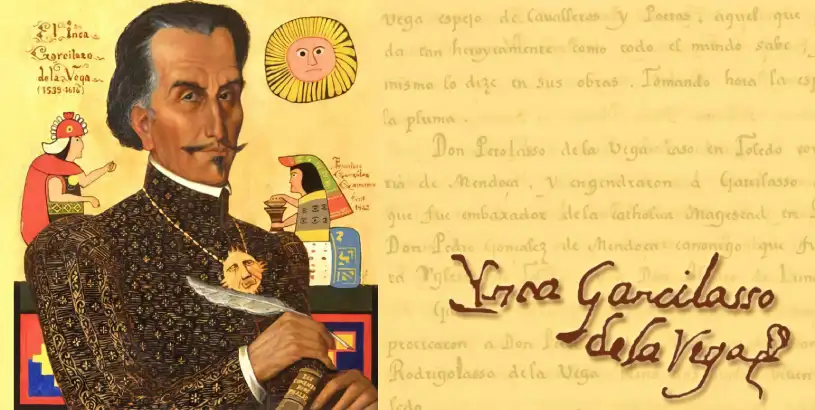Recientes
 Discover the secrets of Transformers in Cusco: Explore the epic locations where the movie was filmed
Discover the secrets of Transformers in Cusco: Explore the epic locations where the movie was filmed
 Cusco, Navel of the World? Explore the fascinating history behind its name!
Cusco, Navel of the World? Explore the fascinating history behind its name!
“The navel of the world,” probably the most widespread meaning attributed to the word Cusco by both Cusqueños and non-Cusqueños alike.
Imagine a time when gods and men were one, when earth and sky were indistinguishable. That was the world according to the ancient Incas’ worldview. But one day, the god Sun, Inti, decided that humanity needed a place from which to be governed, and he chose a valley in the Andean region of present-day Peru. Although popular culture and a lack of interest in deciphering the true meaning of the word Cusco have magnified its significance, a prestigious Peruvian linguist has proposed a much simpler explanation.

Partial view of the city of Cusco from the fortress of Sacsayhuaman.
However, beyond the true origin of its name, the fact is that Cusco is a city that encloses a rich history and a millennia-old culture. Its streets, squares, and monuments bear witness to the grandeur of the Inca empire and the resistance of its peoples against the arrival of Spanish conquistadors. Cusco is undoubtedly one of the most fascinating places in Latin America and a demonstration of the cultural and heritage richness that Peru possesses. What are you waiting for to discover it, along with the history of its fascinating name?
In November 1533, the first Spaniards arrived at the capital of the Tahuantinsuyo, the Inca city of Cuzco, known as “Qosqo” by the native inhabitants and as it would also be mentioned in the oldest chronicles. The insatiable greed of those first Europeans is well-known, while others were captivated by the history and culture of the people they encountered. Among the many questions they had, they were particularly interested in the meaning of the name of this magnificent Incan city, with its stunning palaces and abundance of gold.
What could Qosqo, the name of a place so rich and sacred, possibly mean? This was at least one of the questions that many chroniclers asked themselves and tried to answer after the city fell to the Spanish forces in the 16th century. The results of these early investigations were frustrating, as many of the first chroniclers would later admit. There were also those who attributed their own meanings to the name, a habit that persists to this day, spreading like a viral meme through popular culture and the internet.
Returning to the chroniclers, Juan de Betanzos, probably after a failed investigation, stated in his chronicle: “What the name Cozco means, the Indians cannot explain.” Chroniclers such as Cabello de Balboa, Cieza de León, Cristobal de Molina, and many others preferred not to comment on the meaning.
The question still remains today: why was Cusco called and still is called the “Navel of the World”?
The answer lies in the way the ancient Incas viewed Tahuantinsuyo (ancient Peru). Ancient Peru was a long country, like a human body that was mainly divided into 4 regions. And in the center of that body was the city of Cusco.
The ancient Peruvians saw Cusco as the navel of the country because it was the most important and strategic city of the Inca Empire. From there, Inca emperors controlled the entire territory, from the highest mountains to the farthest coasts.
Over time, the city of Cusco became a very important cultural center, where Inca and Spanish cultures mixed. And it was at that moment when Garcilaso de la Vega, a Spanish writer and historian born in Peru, coined the term “Navel of the World” in his chronicles called “Royal Commentaries of the Incas,” a term he coined based on the function that the Inca capital served as the navel of that great empire of the four directions.
“They placed at the point or center the city of Qosqo, which in the particular language of the Incas means navel of the earth: they called it with good resemblance navel, because all of Peru is long and narrow like a human body, and that city is almost in the middle.”
Garcilaso de la Vega was educated in the Greco-Roman culture of the Renaissance and saw in Cusco a reflection of what the ancient Greeks and Romans had called the “omphalos,” the center of the world. For Garcilaso, Cusco was the cultural and spiritual center of a nation that had been conquered by Spain but still preserved its ancestral roots and traditions.

The mestizo chronicler Garcilazo de la Vega, the first Peruvian mestizo writer.
Thus, the term “Navel of the World” became synonymous with Cusco, and today it is one of the city’s most popular nicknames. But its origin dates back to the ancient view that Peruvians had of their country and the importance that the city of Cusco had as the center of a great empire. This nickname or term has no relation to the true etymological meaning of what the great Inca capital was.
According to the Spanish chronicler Sarmiento de Gamboa, who had the opportunity to interview Inca royal family chiefs, the meaning of Cusco is completely different from what has commonly been spread:
“Ayar Auca, after hearing the words of his brother, flew to the place that Manco Capac had ordered him to. There he sat down and turned into stone, remaining as a landmark of ownership known as Cozco in the ancient language of the valley.”
The chroniclers Sarmiento de Gamboa, Santa Cruz Pachacuti and Martin de Murúa, either directly or indirectly, provide us with the explanation that Cusco means “boundary marker or place where piled stones appear.”
These are the ideas presented by some of the men who ventured to document Inca history in chronicles.
“Rock”: It is also believed that the name Cusco is derived from the Quechua word “qosqo”, which means “rock”. This is because the city was built on a giant rock, which is believed to have been shaped like a puma, an animal sacred to the Incas.
“Fertile valley”: Another possible meaning of “Cusco” is “place of joy” or “place of abundance”, in reference to the fertile Cusco Valley region, which was highly valued by the Incas for its ability to produce crops.
In contemporary times, the most coined translation after “navel of the world” would be “heap of stones” or “place where these stones are piled up” provided by Fernando de Montesinos based on the aforementioned chroniclers. Additionally, there are also translations such as “liso” (smooth), “aplanado” (flattened), among others.
After all these meanings from different authors, the linguist Rodolfo Cerrón Palomino, a specialist in Andean languages, proposes, after years of research, that the word Cusco, derived from Qozqo, means “owl”. The word was found still in use in Orureño Aymara, Chilean Aymara, Chipaya, and other extinct languages that would have shared or borrowed the term. What is curious is that the territories mentioned are neighbors both geographically and dialectically.
It should be clarified that, since it is a very old word dating back to the foundation of Cusco, finding its affiliation in Aymara, it should not be ruled out that this language borrowed the word from another very ancient language widely used in the highlands of the Andes: Puquina language. The language that was probably spoken just by the Inca royalty.
Legend has it that in the great mountain of Pacaritambo (northwest of Cuzco) after a great flood, the god Wiracocha made the Ayar Brothers emerge. On the mountain called Tampu Tocco, the four brothers departed with their respective wives: Ayar Manco and Mama Ocllo, Ayar Cachi and Mama Cora, Ayar Uchu and Mama Rahua, and finally Ayar Auca and Mama Huaco.
Upon seeing the state of the lands and the poverty of the people, the Ayar brothers set out on a journey in search of a more fertile place. They left with members of ten Ayllus (an Inca organization that grouped ten families) towards the southeast. The first problem arose when Ayar Cachi (a strong man) had an altercation with his other brothers.
They wanted to kill him, and Ayar Cachi ordered them to return to the caverns of Pacarina (the place of origins, called so in Quechua) to get seeds and water. Ayar Cachi entered the cavern of Capac Tocco (the main window of the mountain “Tampu Tocco”), and the servant who accompanied him closed the entrance with a large stone, and he could never leave.
The others continued their journey and arrived at the Huanacauri mountain where they found a stone idol, which they feared and respected. But Ayar Uchu jumped on the back of the stone statue and was instantly petrified, becoming part of the sculpture from that moment on. He advised his brothers to continue the journey and asked them to celebrate the Huarachico ceremony, or “initiation of the young” in his memory.
During the journey, Ayar Auca saw that wings and grew on him. On the orders of his brother Ayar Manco, he flew towards the valley. When he arrived at a rock in Acamama (The previous name of the lands of Cusco), he too was turned into stone.
The only remaining brother, Ayar Manco, arrived in Cuzco where he found good land. He sunk his golden staff with ease, but could not pull it out without effort. Excited by the environment, they decided to stay. Ayar Manco founded a city in the name of his god Wiracocha, and in the name of the Sun, this city was called Cuzco and became the capital of the Tahuantinsuyo, the beginning of the Inca Empire.
To find this connection, we must take Sarmiento de Gamboa’s chronicle. He is one of the chroniclers who best transmit the mythical history of the Ayar brothers’ march to Cuzco and the foundation of the city.
According to the Spanish chronicler, Ayar Manco showed Ayar Auca “a stone landmark that was near the site where the Santo Domingo monastery is now” (Qoricancha) and ordered him to go there, saying:
“Go there flying (because they say wings had grown on him), and sitting there, take possession in the same seat where that landmark appears because we will soon go to settle and live”!
“Ayar Auca, hearing his brother’s words, rose on his wings and went to the said place that Ayar Manco commanded him, and sitting there, he turned into stone and became a landmark of possession, which in the ancient language of this valley is called Cozco, from which the name Cuzco remained until today”.
As can be seen, in Sarmiento’s version, Ayar Auca is the character to whom “wings had grown” (an owl). And when he receives the order from Ayar Manco, rising precisely “on his wings,” he went to perch on the “stone landmark” that his brother had indicated, and “sitting there, he turned into stone,” thus joining the “stone landmark.” From then on, Sarmiento reminds us, the Incas had a proverb that said, “Ayar Auca cuzco guanca,” as if to say, “Ayar Auca stone landmark marble.”
That is to say, according to this, Ayar Auca, who was a “cuzco,” that is, an owl, perched on a “guanca,” which is a stone landmark, and turned himself into a rock. In plain words, “cuzco guanca” (qosqo guanca) comes to mean “the stone of the owl,” or giving it a more complete interpretation, “the cliff where the owl perched.” The founders of Cusco could not have had a better motivation to designate the place they were occupying in this way.
From all this, Cusco means Lechuza (Owl) and not the navel of the world.

Cusco means Owl.
Although “Cuzco” was the way to spell its name for centuries, nowadays the trend in Peru is to use “S”. But why?
A commonly accepted theory is that Spanish conquerors imposed the use of “Z” instead of “S”, which was the form used by the Incas. However, experts point out that this interdental pronunciation was not common among the explorers who arrived in the “New World”, who mainly came from southern Spain, where “Z” is pronounced similarly to how it is done in Latin America.
In addition, language scholars assert that there was no mistake in the adaptation of “Qosqo” (the original name) to “Cuzco” by the conquerors, as the “Z” of that time was the most accurate way to imitate what they heard from the native peoples.
Despite this, some Peruvians prefer the option of “Cusco”, arguing that the Incas did not know the “Z” brought by the conquerors. For them, this is a matter of cultural and historical sensitivity.
Whatever option is preferred, the truth is that both forms are equally valid, according to the Royal Spanish Academy. And although the predominant option in Peru is “Cusco”, the form of “Cuzco” remains the most widespread in the rest of the Spanish-speaking countries.
Are you looking for an authentic and unique way to discover Peru? Koa Expeditions has the answer for you. With our personalized service and high level of attention to detail, you can explore Peruvian destinations in a way that suits your needs and desires. At Koa Expedition, we are passionate about providing unforgettable experiences and vibrant adventures throughout Peru’s coast, highlands, and jungle.
Our team of local experts will guide you on a journey through Peru’s rich cultures, breathtaking landscapes, and exotic wildlife. From the beaches of the coast to the heights of the Andes and the depths of the jungle, we will take you to magical and lesser-known places, straight out of your dreams.
With Koa Expedition, you can experience unique adventures, such as walking along the ancient paths of the Incas, discovering the secrets of Peruvian cuisine, and observing wildlife in its natural habitat. Our personalized service and detailed approach ensure that every moment of your adventure is memorable and tailored to your interests.
Peru awaits you! Let Koa Expeditions be your guide in search of the most vibrant adventures throughout the Inca lands. Dare to discover Peru in an authentic and unique way with us. Contact us now to start planning your trip.
Made with in Perú